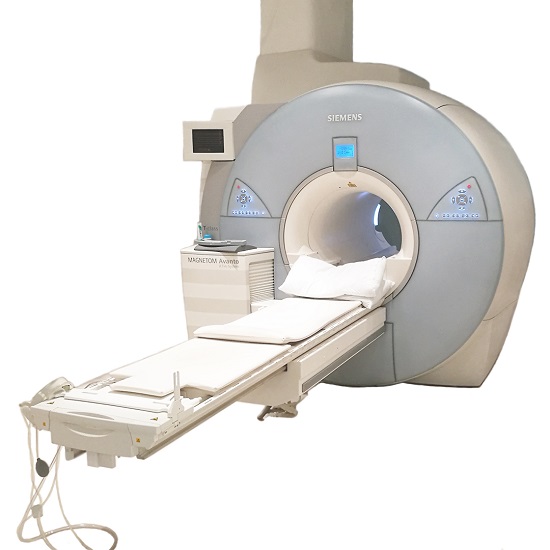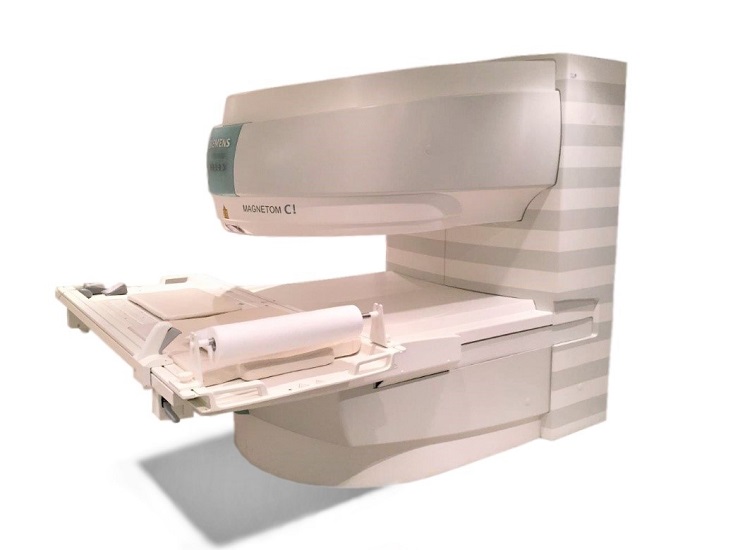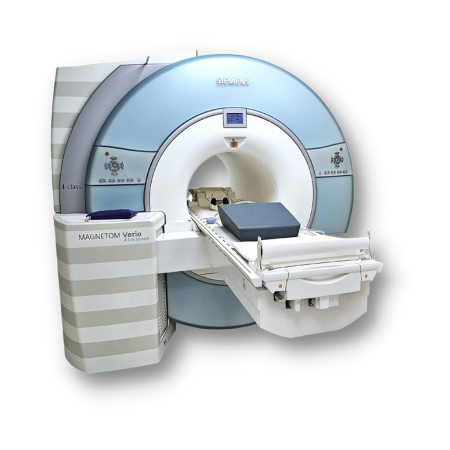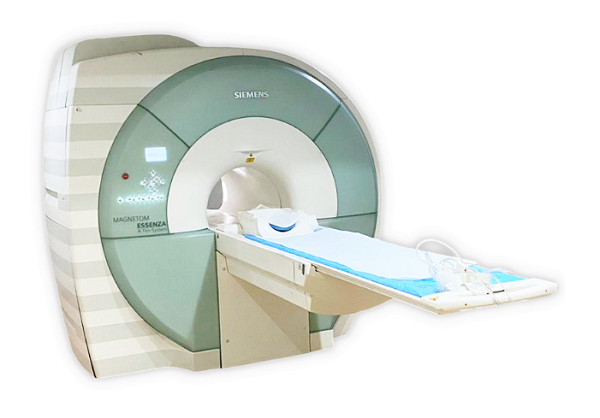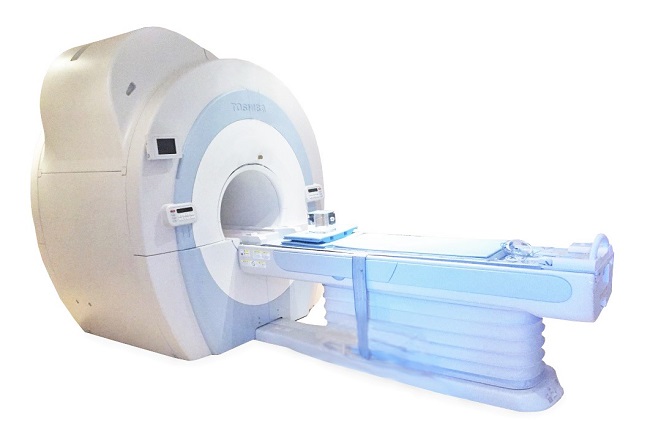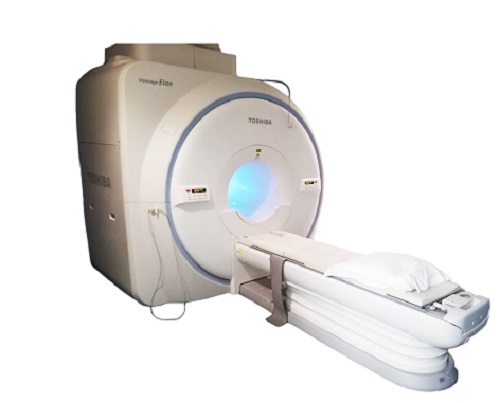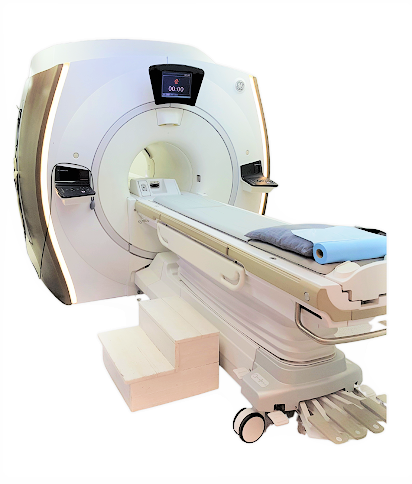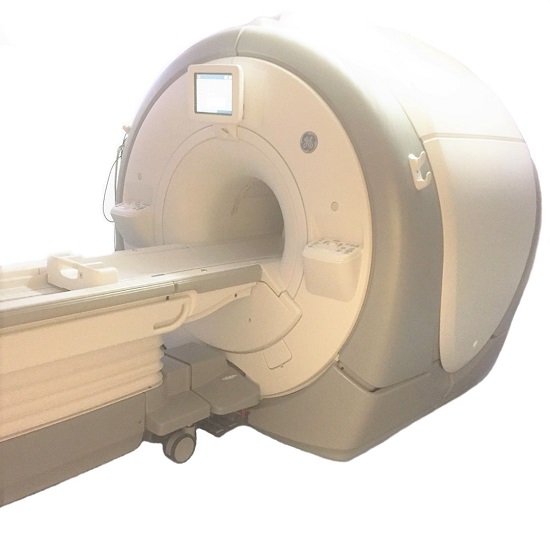Types of MRI Machines – MRI Manufacturers, Teslas, and Models
This article has been updated 18-10-2023
MR Imaging is a type of diagnostic that uses magnetic resonance techniques, radio waves, and a computer to produce accurate images of the tissues of the body.
Therefore, an MRI scanner is one of the most valuable systems for any hospital and imaging clinic.
You can find different types of MRI machines for diverse applications, with various magnetic strengths, capabilities, and price ranges.
So, how to know which one suits your needs the best?
In this guide, we give you a comprehensive overview of types of MRI machines and the many options you may consider when purchasing an MRI machine.
If you prefer, you can sign up for our e-mail course, which will walk you through the main points of this article. That will also give access to this article as an e-book you can download.
Get the MRI mail course
You can also watch our video explaining MRI scanner pricing:
How Does an MRI Scanner Differ from a CT Scanner?
CT and MRI are similar in capabilities in terms of scanning internally and offering cross-sectional images, but how do they compare to one another?
MRI and CT scanners enable physicians to diagnose effectively and detect many diseases and abnormalities even at early stages.
When comparing the two:
- CT scanners are typically better at imaging bones, while MRI systems provide better soft-tissue contrast.
Furthermore, MRIs distinguish more adequately between fat, water, muscle, and other soft-tissue structures such as ligaments and cartilages.
In general, MRI machine provides more detailed images of the internal organs (soft tissue) such as the brain, skeletal system, reproductive system, and other organ systems. For that reason, it is the standard diagnostic test for the nervous system and brain problems such as multiple sclerosis and spinal cord lesions.
You would use an MRI to:
- Diagnose tendon and ligament injury
- Detect and evaluate spinal cord issues
- Evaluate soft tissue in more detail
- Monitor brain tumours
- Examine complicated abdominal abnormalities
You would use a CT to:
- Find and diagnose injuries from trauma
- Determine the location and size of a tumor
- Determine cancer stages
- Diagnose infections
- Detect the location of blood clots
- Diagnose conditions of the lungs and heart
- Identify vague abdominal problems
Other differences between MRI and CT Machines
MRI machines are noisier than CT scanners, and some patients find them uncomfortable.
Their opening is quite narrow and may trigger claustrophobia. While the MRI scanner bore openings are between 60-70 cm, most CT scanner’s bore openings are between 72-90 cm and are more accommodating for patients with claustrophobia.
However, open MRI systems have an advantage over both in this category.
Furthermore, MRI scans take longer, from around 15 minutes up to 1 hour or so, while a CT scan usually takes 1 up to 20 minutes, depending on the examination. Therefore, CT scanners are preferable if time is a factor, for example, in an emergency room.
Unlike CT scans, MRIs do not expose patients to radiation. However, not all patients can be examined using an MRI scanner. These include patients with specific implanted medical devices.
Today, some metal implants are considered safe for MRI scanning. Doctors must always evaluate and approve, however, those implants are likely to cause metal artifacts. Some of the large MRI manufacturers are offering solutions to tackle this issue, if this is a concern for your practice, feel free to write us and our team of experts will be happy to guide you towards the best solution.
More than ever, the need for the right guidance and consultation is crucial to the success of projects as such.
We hope we answered the question: How does an MRI Scanner differ from a CT scanner?
If you have any additional questions, feel free to reach out.
Otherwise, let us look at types of MRI machines offered by MRI manufacturers.
Premium MRI Machine Manufacturers
MRI brand manufacturers have different advantages.
Some MRI manufacturers offer better purchasing price, while others have a lower service cost. However, not all MRI scanners perform equally across the board.
The main brands of MRI scanners are Siemens, GE, Philips, and Canon Medical (formerly Toshiba).
All of these MRI machine brands offer high-quality MRI equipment and maintain good value as pre-owned systems.
Siemens MRI Machines
When it comes to MRIs, Siemens has been making tremendous progress.
For example, their TIM systems (Total Imaging Matrix) allows whole-body imaging without the need for re-positioning of patient or multi-scans. And thus, offering better image quality, higher SNR and faster scans.
When incorporated with the DOT technology (Day Optimizing Throughput), MRI systems will have increased productivity, ease of use, and consistent scan results. DOT engines offer twice as many standard applications in your MR system.
Siemens low-powered systems are highly appreciated around the world, especially in India and Africa. The Magnetom Essenza is a system that consumes very little power and requires no chiller or extra cooling. That makes the system very attractive in many different places around the world.
All Siemens systems available in the used market today are zero helium boil-off:
- Magnetom Essenza 1.5T
- Magnetom Avanto 1.5T
- Magnetom Espree (Large bore) 1.5T
- Magnetom Aera (top of the line 1.5T)
- Magnetom Spectra 3.0T
- Magnetom Verio 3.0T
- Magnetom Skyra (top of the line 3.0T)
Siemens is one of the most versatile MRI providers with over 13 different systems in their current production line, between 1.5, 3.0, and 7.0 Tesla.
Examples of Siemens MRI Machines
View AllToshiba / Canon MRI Machines
Let’s look at the different types of MRI machines that Canon Medical offers.
Canon MRI systems are known for their excellent image quality with reasonable prices. With Canon, you do not need to increase your budget to purchase the very high-end models and get the equivalence of DOT technology.
M-power is a standard configuration and available on all Vantage series from 2010 onwards and accessible at almost half the price of systems with DOT technology.
M-power streamlines and speeds up processes to improve the performance of your MRI. In addition, it offers a powerful user interface that is easy to navigate and contributes to better efficiency.
Canon systems are known for their great combinations. The gradient provides excellent spatial encoding of RF signals; the highly homogenous magnetic field, and high SNR directly improve image quality. However, these systems are some of the few remaining MRIs in the market without a zero-helium boil-off magnet.
When using a Vantage Titan, you must expect yearly refills of helium. Service is not as widely available as for Siemens and GE, and if the service is available in your region, then Canon may be a great option.
Canon offers the largest FOV of all MRIs to date on the Vantage Titan 1.5T with a bore 71cm wide. Also, they provide the best noise reduction, which uses a vacuum to eliminate noise created by the magnetic field.
Canon also produces newer models that have a zero boil-off magnet, providing some of the best low-powered MRI systems such as the Vantage Elan.
These systems are incredibly easy to install, with the lowest power requirement of any system in the market (25KW). Yet retaining world class image quality while lowering the annual running cost of your system to the minimum.
Some of Canon MRI systems available in second-hand market:
- Vantage Titan 1.5T
- Vantage Elan 1.5T (zero helium boil-off magnet)
- Vantage Orian Upgrade 1.5T
- Vantage Titan 3.0T (zero helium boil-off magnet)
- Vantage Galant 3.0T (zero helium boil-off magnet)
Examples of Toshiba/ Canon MRI Machines
View AllGE MRI Machines
GE supplies reliable systems that are easy and cheaper to service and offer great qualities. Moreover, GE is the pioneer in the development of zero helium boil-off MRIs.
Their MRI systems offer great capabilities supported by the world’s best software and a long list of advanced applications often available as a standard configuration.
For example, the GE Discovery MR 450 offers 32 channels, various sequences, and possibilities, which makes it a very attractive option for any hospital.
GE MRIs are easy to service and have reasonable spare parts prices, which is also necessary to consider. Over the years of using your MRI scanner, service becomes more and more important, and keeping these costs as low as possible will increase your profitability. Although the system might be little expensive upfront, the low running costs will make a difference in the long run.
GE Optima MR 450W is still considered one of the most demanded systems in the pre-owned market. It combines good pricing, reasonable service cost, and outstanding performance.
In recent years, GE have increased its line-up of MRI systems, and are expected to gain more shares in the market, having great systems such as:
- Signa Discovery HDxT 1.5T
- Optima MR360 or Brivo MR355 1.5T
- Discovery MR450 1.5T
- Optima MR450w 1.5T
- Signa Explorer 1.5T
- Signa Voyager 1.5T
- Discovery 750 3.0T
- Discovery 750w 3.0T
GE MRI Machines
View AllPhilips MRI Machines
Philips provides good MRI systems. They are reliable but can be quite costly to purchase and service. The image quality is famously hailed as one of the best.
Philips offers precision and a varied range of applications, but their use can be more complicated than what you see with Canon, GE, and Siemens models.
Philips zero helium boil-off systems were less common in previous years and more expensive in the used market. However, they are becoming more accessible and are truly quality magnets. Their non-zero boil-off magnets have the best and lowest boil-off rates of all MRIs, thus, deliver excellent value.
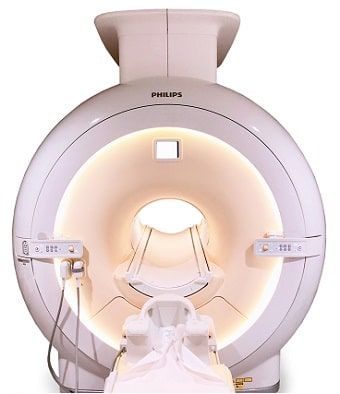
Currently, Philips has the bragging rights for the world’s first near helium-free MRI system. The magnet, which is completely sealed-in, contains 7 litres of liquid helium only and requires no refills.
Therefore, it does not need any ventilation. The first installation took place in September 2018 and we may expect to see this MRI in the second-hand market in the next 5-7 years.
MRI systems from Philips available in second-hand market:
- Panorama 1.0T
- Achieva Nova 1.5T
- Philips Achieva 3.0T REX
- Intera Achieva 1.5T
- Achieva 3.0T
- Philips Achieva 1.5T
Finally, not all regions have similar accessibility to service for all brands. Therefore, service accessibility, spare parts costs, and repairability should also be considered when deciding on an MRI.
The prices of the different MRI models vary depending on various factors, including the brand. We will look into MRI scanner pricing later, but before that, let us explore the differences between open and closed MRIs as well as between low and high-field MRI scanners.
Differences between Closed and Open MRI Machines
You may have heard about open and closed bore MRI systems before.
So, how do they differ overall?
Let us go over these two types of MRI machines.
Open MRI Machines
As the name suggests, this type of MRI machines is open. Most open MRIs do not use superconducting magnets, they use permanent magnets (resistive magnets). Thus, instead of liquid helium, they use water and air cooling, which is less expensive in terms of labour and money.
However, there are some exceptions: A 0.6T, 1.0T, and 1.2T, for example, are completely open bore MRI scanners with superconductive magnets, which utilize the use of liquid helium.
Open bore MRIs use two parallel magnets with an opening in between to produce images. Since MRI technologies are constantly evolving, there are nowadays technologies in the market where the magnets are set upright, producing an axial image.
Open MRIs are primarily designed to suit larger patients and patients struggling with claustrophobia. And because most open MRIs are low field, using less than 0.5T, it can be a challenge to tell fat and water apart during the scan, which can result in lower resolution images.
Nevertheless, since the technology is progressing, the clarity of the low-field MRIs has increased over time. Hence, an open MRI can balance your imaging needs, capital costs, and patient comfort.
Closed MRI Machines
This type of MRI is the most demanded in the market, due to speed, image quality, variety of options and sequences. A closed MRI has the shape of a “donut”. Unlike open MRIs, closed MRIs do not come with a permanent magnet option, they are always superconductive, which generates an astounding amount of heat, therefore, liquid helium is required to maintain the superconductivity of any high-field magnet.
Generally, closed magnets start at 1.5T. However, since they are closed, many patients struggle with the feeling of claustrophobia. The systems may be uncomfortable for obese patients. Therefore; wide bore, also called large-bore MRIs were developed. All top manufacturers nowadays offer a 70cm “wide bore” option.
Just to give you a few examples:
- Siemens Espree, Aera, Altea, Sola 1.5T / Verio and Skyra 3.0
- Philips Ingenia and Ingenia Ambition 1.5T/ Ingenia 3.0T, and Ingenia Elition 3.0T
- GE 450W, Voyager, and Creator 1.5T/ MR750W, Signa Pioneer 3.0T
- And Canon Medical offers a 71cm bore in their Vantage Titan, Orian 1.5T, and Vantage Galan 3.T
Overall, closed MRI scanners scan faster and are suitable for a higher number of applications, as you can see in the table in the next chapter.
But enough about open and closed MRIs. Let us investigate MRI field strength, which is measured in Tesla.
MRI Field Strength – Measured in Teslas
For now, let us get an overview of the Magnetic Field Strength (MFS) measures in Tesla.
When medical practitioners refer to MRI scanners, they often say that the scanner is a 1.5T or 3.0T MRI.
That is because MRIs are defined by their magnetic field strength measure in Tesla (T), and the higher the Tesla, the stronger the magnet.
Fun fact: The 1.5 Tesla MRI is 15,000 gauss, the Earth’s magnetic field on the surface is anywhere between 0.25 – 0.65 Gauss, which is 23,000 to 60,000 times stronger than the gravity of the planet Earth.
Across the MRI industry, the most common scanners are 1.5T or 3.0T. Nevertheless, you can find MRI scanners with strength below 1.5T, such as the 0.2T, 0.3T, 0.4T, and also MRIs up to 7.0T. Since 7.0T MRIs are less common and usually only appear in clinical research institutions, we do not cover them in this guide.
Low-field MRI Machines: 0.2T – 0.4T
Most of these systems are open bore MRIs with a very small exception, of extremity dedicated MRI scanners. Although the MR market is dominated by superconducting magnets with a field strength of 1.5T and higher, a lower field scanner also has certain advantages. For example, lower initial purchase price, operational costs, service, and annual running costs.
Furthermore, low-field MRIs are a good alternative for claustrophobic or uneasy patients. Typically, practitioners utilize a 0.2T MRI scanner for extremities only, while 0.3T and 0.4T MRI can also be applied in full-body examinations.
High-field MRI Machines: 1.0T, 1.2T, 1.5T and 3T
These systems are very powerful. As mentioned, the higher the Tesla, the stronger the magnetic field, which leads naturally to better images. While most currently available 1.0T and 1.2T MRIs are designed as open MRIs, 1.5T and 3T are closed. Since 1.5T and 3T are currently the most common in the market, let us look at them in more detail.
1.5T MRI Scanners
Nowadays, 1.5T MRIs are the standard in MRI imaging in a clinical setting. They are faster than lower strength MRIs and are sufficient for the majority of routine scans done today. Therefore, they account for most MRIs currently in use.
Typically, you would use 1.5T MRI scanners for:
- General imaging
- Extremities
- Cardiac imaging
3T MRI Scanners
When performing examinations that need to be very detailed, you should consider a 3T MRI scanner.
3T will shine in specialties such as:
- Advanced brain imaging (DWI, DTI spectroscopy)
- ASL (brain perfusion)
- Prostate scans
- fMRI
- Blood prefusion
- Bone marrow
So, if you do not intend to focus on a specialization such as brain imaging, the 1.5T MRI will give you the image detail you need at a lower cost than the 3T MRI.
To get a better understanding of what exams can be performed by the different Teslas MRIs, check the table below.

Because the 1.5T and 3T are closed MRIs, some patients may find them claustrophobic.
In addition, the purchase prices of the latest models can be high. The same applies to their maintenance costs, which are higher because these MRI scanners are helium-cooled.
And now, let us take a closer look at MRI pricing.
How Much Does an MRI Scanner Cost?
First and foremost, we should make ourselves clear. We are describing the prices of MRI scanners on the used market.
The prices of used MRIs are usually 50-80% lower than the prices of brand new. And the prices of OEM refurbished MRIs are typically 35-45% lower than the prices for new systems.
If you have read our CT Guide, you may know that the price of used CT scanners varies greatly. It can go from 35.000 to more than 250.000 euros.
This range is slim compared to that of used MRIs. You can find MRI systems ranging from 30.000 up to 700.000 euros. So, you should be clear on your needs before making up your mind.
Some cheaper MRIs are only suitable for extremity examinations. On the other hand, the most expensive MRIs may only be required if you perform advanced examinations, such as sophisticated brain studies, bone marrow, prostate scans, or blood perfusion.
Here is an example of the price difference between open MRIs:
Some of the cheapest MRI systems on the secondary market are the Esaote E-scan & C-Scan. These extremity scanners are a good choice for orthopaedists and veterinarians. The price of these two models starts at 30.000 euros.
Systems such as Siemens Magnetom C! or Hitachi Airis, and Aperto series have the capability of performing more applications such as neuro and cardiac. These may cost between 200.000 to 300.000 euros. See a price overview below.

MRI scanners with a stronger magnetic field such as 1.5T or 3.0T are much more expensive. These can be divided into two categories:
- Regular helium boil-off systems, which have high maintenance costs as they require helium refills on an annual basis.
- Then there are zero boil-off magnets that are pricier than regular magnets, however, they are much cheaper to maintain since they do not require helium refills for up to 10 years.
Nevertheless, if you opt for a zero boil-off magnet, you should expect a high start-up cost. The price difference between the zero boil-off and regular boil-off MRI can start at 50.000 euros.
An example of the initial price difference for a full MRI project:
Siemens Magnetom Avanto 1.5T is a zero boil-off magnet. A price for a full project including a used Magnetom Avanto will be around 460.000 euros, if you prefer a refurbished system, the price can go up to 600.000 euros.
On the contrary, a full MRI project that includes the Toshiba Vantage Titan 1.5T will cost you around 350.000 euros when used and up to 500.000 euros when refurbished. This system boils off helium and thus its running cost will be higher as it requires helium refills.
As you may understand, MRI pricing on the used market can get a bit complicated. To make it easier for yourself, see the matrix below.
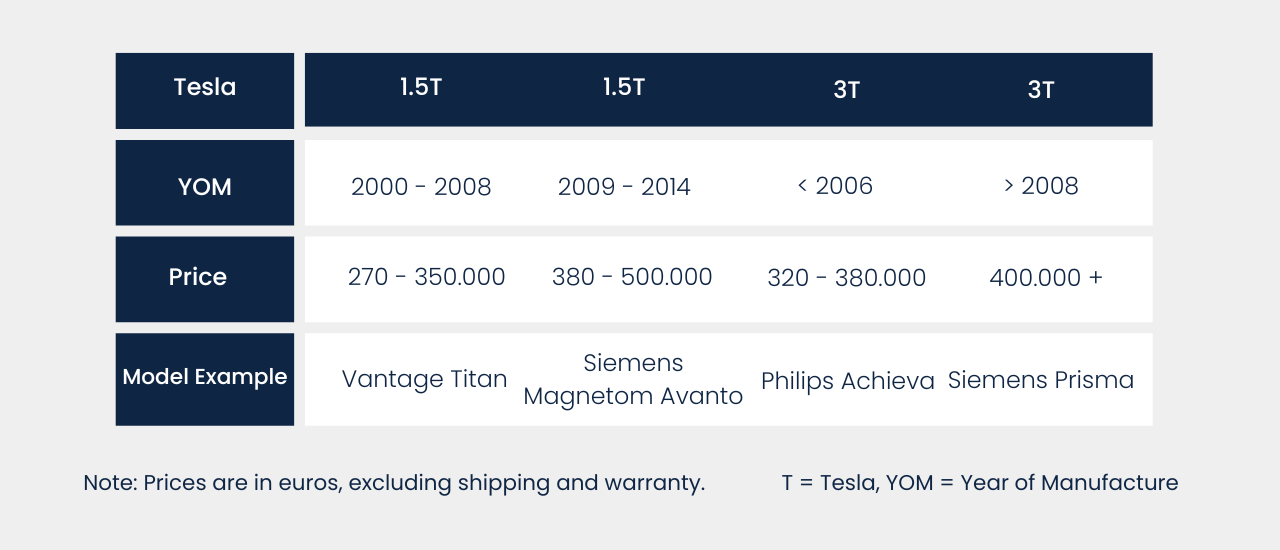
Some of the factors that affect the prices of MRI scanners are:
- Year of manufacture (YOM)
- Field strength
- Gradient strength
- Slew rate and channels
- MRI coils
- Helium cost
- Delivery cost
- Installation and warranty
Maintenance Costs of an MRI Scanner
What about the maintenance and running costs of an MRI scanner?
As we emphasized previously, the golden rule of purchasing MRI systems is access to service. The quality of the MRI system could be irrelevant if the service provider of the specific brand is not available in your region.
It is important to note that the MRI system should not only suit your purchasing budget, but also your yearly maintenance budget. To cover maintenance or service costs as well as helium refills. These costs vary from system to system. And it will also depend on the MRI parts prices.
If you decide to purchase a newer model, the maintenance will be lower than for an older system. That is because newer models burn less helium, and thus, do not need helium refill as often. Nevertheless, the purchasing price of a newer model will be significantly higher.
Moreover, if you only need a smaller system, permanent magnets ranging from 0.2T to 0.4T can save you some money as they are not helium cooled.
We have mentioned helium several times in this section, so let us dive in a bit deeper.
The Importance of Liquid Helium in MRI
Why is liquid helium used in MRI machines?
Permanent magnet MRIs from 0.2T to 0.4T do not require any liquid helium for cooling. Higher field MRI systems ranging from 0.5T to 1.2T require less liquid helium than 1.5T MRI scanners.
But why does 1.5T, 3.0T and 7.0T require so much of liquid helium?
Because they are superconductive magnets and require liquid helium to cool them to the temperature in which they are superconductive. The amount of helium used varies from one system to another.
On average one 1.5T requires 1.600 litres of liquid helium to maintain the superconductive temperature of 4.1 Kelvin (-269 Celsius), with boil-off rates between 0.1l and 0.01l per day, depending on the system. When helium boils off, for various reasons, the magnet eventually becomes warm if nothing is done about it. The word warm is loosely used as the alternative to “the magnet is no longer superconductive”, meaning that it is not cooled down to the 4.1K needed for superconductivity.
Some systems are great at maintaining the low temperature, allowing very little or no helium to boil off. Hence their name, zero boil-off MRIs. They are also called 4K systems as they maintain the temperature of 4 Kelvin, which ensures that helium remains in its liquid state, rather than turning into gas and dissipating.
As we mentioned, helium affects the ongoing costs of an MRI. It can get expensive. Its price varies depending on the overall demand in the market and based on your location. In addition, the price is also dependent on the quantity you buy.
If you own zero boil-off helium magnets like the Siemens Magnetom Avanto or Toshiba Vantage, you do not have to worry too much about the rising price of helium. A zero boil-off MRI system will not require helium for the next 10 years under optimal working conditions. On the other hand, MRI that gradually boil off helium will require refill every 11 to 18 months depending on the system.
But how much liquid helium does an MRI scanner boil off?
As mentioned above, zero boil-off MRI systems will not require refill, the helium loss occurs at very low rate during service and exchange of the cold head.
For other systems, the helium boil-off rates vary as they have different types of magnets. However, there are not many left in the market: Achieva, and Intera Achieva use F2000 magnet, which has 0.03l/h boil-off rate. And for instance, the Vantage Titan has the OR76 magnet, which boils off about 0.05l/h.
Hence, your usage of helium is hugely affected by whether you have a zero boil-off or a regular magnet that boils off helium gradually, which will increase your maintenance cost.
For more examples on how much it will cost you to run an MRI scanner, read Liquid Helium in MRI Machines – Use, Cost, and More.
Another factor affecting MRI scanner price are MRI coils. Let us learn more about them.
MRI Scanner Coils
Coils are important for both function and price of the MRI. An MRI coil is basically a probe made of copper loops that transmits and/or receives radio frequencies that are responsible for creating the scanned image in MRI.
There are many MRI coils types, each coil designed to fit and serve certain purposes and applications.
What Are the Most Common MRI Coils?
Coils are directly responsible for acquiring images during MRI scanning. You can find them in different sizes and shapes, depending on the body part being scanned. When choosing a coil, make sure that the coil is compatible with your MRI scanner and that it matches the exams you are going to perform.
Usually you get a set of commonly used coils together with you MRI scanner. Those will cover your needs for most scans. It can vary based on a manufacturer, but in general most MRIs come with:
- Head coil
- Neck coil
- Spine coil
- Shoulder coil
- Body coil
- Knee coil
- Large and small GP flex coil
In 2003/2004, Siemens introduced their TIM technology. TIM works with matrix coils that offer higher SNR and thus better image quality. Compared to previously manufactured MRI coils, matrix coils have a much higher density and more elements to ensure that more data is encoded. However, if you have an MRI scanner with TIM but your coils are not matrix coils, you cannot use it to your full advantage.
This way Siemens started the revolution of coils, but similar technologies were then developed by manufacturers such as GE, Philips, and Toshiba (now Canon Medical).
You should keep in mind that coils are an expensive part of an MRI scanner. A new coil can range from 10.000 to 100.000 euros. Buying these coils second hand can save you more than 50%. If you are unsure about buying used, refurbished or new, read the next section and find out what it actually means.
Check our inventory of MRI coils for sale.
Difference Between Used, Refurbished, and New MRI Scanners
Since you might be a bit confused about the various categories associated with MRI scanners, such as used, refurbished and OEM or ISO refurbished, let us give you an explanation to each.
Used MRI Scanners
The term used MRI scanner may mean different things for different suppliers. They might have different standards when it comes to pre-owned equipment.
Some may just move the system and sell it in the same condition and with the same options as the previous owner had.
On the other hand, other suppliers clean and test the MRI scanners by professional technicians before de-installation and ensure that you get the highest possible quality. In general, used MRIs are much cheaper than new equipment.
Additionally, when you buy from a reliable supplier who provides you with a quality system, you get good value for money.
Refurbished MRI Scanners
Typically, refurbishment of MRI scanners includes cosmetic aspects, such as cleaning, painting, or replacing covers, and functionality, like parts replacement or unlocking options available for the model. But it depends on your supplier, some do not offer this.
Refurbishment gives you greater security and increases the quality of your MRI scanning. Therefore, the price is higher than for used MRIs. A properly refurbished MRI system will cost around 55% – 65% of the price of a brand-new system.
LBN Medical takes pride in the work we do. Our refurbished MRIs go through a very thorough process. We make sure that you not only receive a working system, but also a system that is more reliable. Contact our team to receive more materials and information on our refurbished product lines.
New MRI Scanners
It is straightforward what a new MRI scanner is. A new MRI system has never been used before and you are its first owner.
It comes with benefits such as latest technologies and thus increased image quality. However, the upfront costs are generally almost twice as much as a refurbished MRI scanner, and up to four times as much as the price of a used system. Hence, consider your budget before jumping into buying a new system.
Types of MRI Machines & What Do I Need to Know When Purchasing an MRI Scanner?
You may feel a bit overwhelmed by all the information, so let us make a quick recap of the key points to consider when considering the different types of MRI machines.
What type of studies will I perform?
The answer to this question is essential to know what type of MRI scanner you should acquire. Hence, let your supplier know whether you focus on general imaging, extremities, cardiac, brain imaging or other as this will guide the decision of which model to pick.
What MRI scanner brand is the best for my practice?
What number of Teslas do I need?
How much does a used MRI scanner cost?
What is the role of liquid helium in MRI scanners?
What is a zero boil-off MRI scanner?
What MRI coils do I need?
Thanks for reading this far
If you have come this far in this guide to MRI scanners and still have questions, please contact us. You can get further help from our professional team.
We have almost 20 years of experience with MRI scanners with many happy customers all around the world, reach out if you want us to help you too.
If you would like to get access to our latest e-mail MRI course, sign up below.

